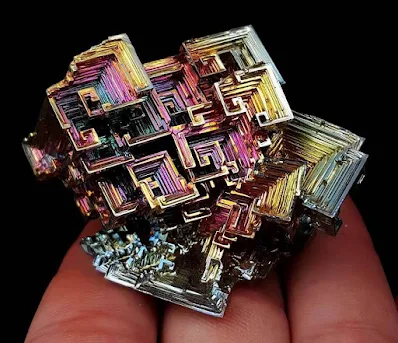What is Hopper Crystal
A hopper crystal is a form of crystal characterized by its stepped or pyramidal shape, resembling a miniature staircase or pyramid.
A Hopper crystal is a distinctive form of crystal growth where the edges develop more rapidly than the faces, creating a structure that resembles a stepped pyramid or a hopper. This formation occurs due to differential growth rates across the crystal's structure, particularly where the edges of the crystal grow faster than the faces.
The phenomenon begins at the molecular level, where the edges of a crystal, having more available high-energy sites for molecule attachment, experience accelerated growth. This leads to a structure where the crystal's edges are well-developed, but the central areas of the faces remain underdeveloped or hollow, resembling a hopper container.
The creation of Hopper crystals is often linked to rapid changes in the surrounding environment, such as quick evaporation or cooling. For instance, in the case of halite (salt), rapid evaporation in environments like salt flats can lead to the formation of these crystals. Similarly, bismuth, when cooled from its molten state, can form Hopper crystals with striking iridescent colors due to oxide layer interference.
 |
| Hopper Halite crystal from Searles Lake, Trona, California. Photo: Crystalminer |
Visually, each face of a Hopper crystal looks like a series of concentric terraces, descending towards the center. This isn't because material was removed but rather because the crystal grew so quickly that there wasn't sufficient time or material to fill in the center, leaving a hollow or stepped lattice.
Hopper Crystal Examples
Bismuth: When bismuth cools from its molten state, it can form Hopper crystals with a stepped, terraced structure, often showcasing iridescent colors due to oxidation.
Galena: This lead sulfide mineral can exhibit Hopper growth under certain conditions, although it's less common than in some other minerals.
Quartz: In the context of quartz, hoppering leads to what are known as skeletal or fenster (German for "window") crystals. These occur when the crystal grows rapidly at the edges, forming a hollow or window-like structure.
Gold: Gold can form Hopper crystals, particularly when it crystallizes from a vapor or solution in a very rapid manner, leading to dendritic or hopper-like formations.
 |
Natural halite crystal from Sieroszowice mine, Poland |
Calcite: Calcite can exhibit Hopper growth, especially in environments where growth conditions change rapidly, like in some cave formations or in laboratory settings.
Halite (Salt): One of the most classic examples, halite forms Hopper crystals in environments with rapid evaporation, like salt flats or evaporation ponds.
Water (Ice): Ice can form Hopper crystals under certain atmospheric conditions, particularly when supercooled water droplets freeze rapidly, leading to hollow columnar or tabular ice crystals.
 |
| Hopper Galena crystals. Photo: Quebul Fine Minerals |
 |
| Hopper halite from Sieroszowice mine in Poland. Photo: Spirifer Minerals |
 |
| Manmade Bismuth crystals. Photo: Gem_stallion |
Studying Hopper crystals provides insights into the conditions under which crystals form, which is invaluable for both geological studies and industrial applications. In industries, controlling crystal growth to either encourage or prevent such formations can be crucial for the properties of the final product, particularly in pharmaceuticals or materials science.




%20(1).webp)



